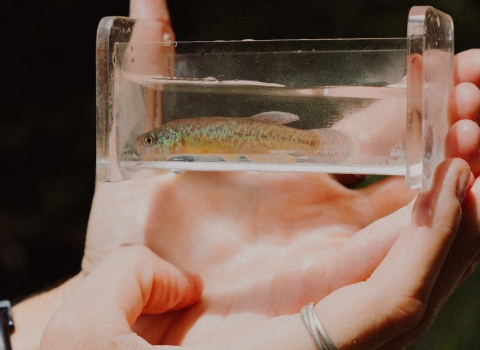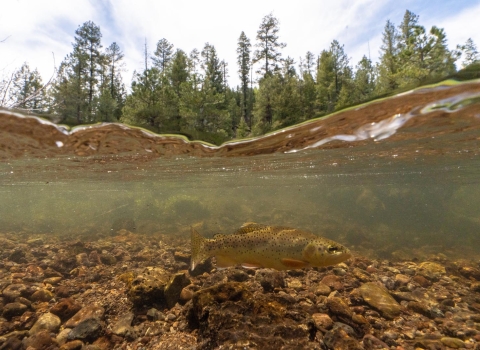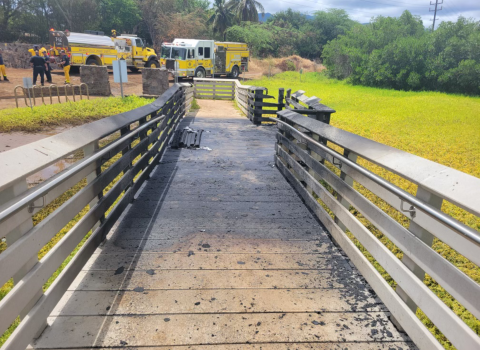Press Release
Endangered Short-Tailed Albatross Hatches at Midway Atoll National Wildlife Refuge
(Midway Atoll, HI) A short-tailed albatross chick hatched at Midway Atoll National Wildlife Refuge on Eastern Island within the Papahānumokuākea Marine National Monument on January 9, 2014. The short-tailed albatross is one of the most endangered seabird species in the world, has a stunning golden head and an impressive regal stature much larger than its cousin, the Laysan albatross which nests on Midway by the hundreds of thousands.
“A year ago last fall, the male returned and patiently waited but the female returned too late in the season and did not lay an egg,” noted refuge biologist Pete Leary. “We were therefore thrilled when this past fall a remote camera technician sighted the female reuniting with the patiently waiting male that appeared the week before.”
Both parents took their brooding duties seriously this year as they have in the past, exchanging places approximately every 2 weeks. While away from the nest, the parent will use its impressive 8.5 foot wing span to cover thousands of miles, soaring between Midway Atoll Refuge and the nutrient-rich ocean waters some 1,000 miles to the North in an intense effort to gather food to feed its chick and acquire enough squid and flying fish eggs to sustain itself.
Midway Atoll Refuge Manager Dan Clark said of this year's hatching, "We are always excited and guardedly optimistic that this chick will grow strong and healthy enough to fledge like the two previous chicks hatched on the refuge. Like chicks in any albatross colony, the young bird will depend on both parents for its growth and survival. Unfortunately, an ever increasing amount of floating plastic debris is intermixed with albatross food sources in the ocean. When the debris is inadvertently swallowed by the adults and later fed to chicks, it can seriously compromise their well-being,” Clark said. “However, this couple has raised two short-tailed albatross chicks that have survived to the fledging stage so we know this chick has attentive and experienced parents.” Along with the hazards of plastic and other human caused impacts they face the risk of death so each successful fledging is cause to celebrate.”
“The nest site is continuously monitored by refuge staff via a remote camera controlled on nearby Sand Island,” noted refuge visitor services manager, Ann Bell. “For the first time we will be able to post on-line video clips of the parents caring for the chick.”
This is only the third hatching in recorded history of a short-tailed albatross any place other than two small islands near Japan. The 27 year-old male and 11 year-old female first met six years ago near their current nest site. This pair raised their first chick in 2011 which amazed the scientific community by successfully fledging despite large storm waves in January and the March 2011 Japanese tsunami that washed the young bird from its nest site twice before it was able to fly.
Once the most abundant albatross species in the North Pacific, short-tailed albatross were hunted for feathers and by 1949 were thought to be extinct. A few birds were seen nesting on the Japanese Island of Torishima in the early 1950s and protection soon followed. Primarily due to international treaties and the work of Japanese researchers, the short-tailed albatross population is on the road to recovery at over 2,200 now in existence nesting on three Pacific islands.
Upon visiting Midway Atoll Refuge’s remote nest site a few years ago, famed Oceanographer, Dr. Sylvia Earle described the abundance of recovered endangered species and habitats by referring to the refuge as having “hope spots” and being a “model for the world.” This particular hope spot now provides encouragement for the continued recovery of this endangered species and brings increased hope for other species, including ourselves. By this summer, the chick at the refuge will hopefully grow strong and skilled enough to leave the island, bringing increased hope for the species and the health of our oceans.
Photos and video are available at http://www.fws.gov/refuge/midway_atoll/ and http://www.flickr.com/photos/usfwspacific/sets/72157626287199106/with/10875138644/
Additional point of contact: Pete Leary at 808-954-4819
“A year ago last fall, the male returned and patiently waited but the female returned too late in the season and did not lay an egg,” noted refuge biologist Pete Leary. “We were therefore thrilled when this past fall a remote camera technician sighted the female reuniting with the patiently waiting male that appeared the week before.”
Both parents took their brooding duties seriously this year as they have in the past, exchanging places approximately every 2 weeks. While away from the nest, the parent will use its impressive 8.5 foot wing span to cover thousands of miles, soaring between Midway Atoll Refuge and the nutrient-rich ocean waters some 1,000 miles to the North in an intense effort to gather food to feed its chick and acquire enough squid and flying fish eggs to sustain itself.
Midway Atoll Refuge Manager Dan Clark said of this year's hatching, "We are always excited and guardedly optimistic that this chick will grow strong and healthy enough to fledge like the two previous chicks hatched on the refuge. Like chicks in any albatross colony, the young bird will depend on both parents for its growth and survival. Unfortunately, an ever increasing amount of floating plastic debris is intermixed with albatross food sources in the ocean. When the debris is inadvertently swallowed by the adults and later fed to chicks, it can seriously compromise their well-being,” Clark said. “However, this couple has raised two short-tailed albatross chicks that have survived to the fledging stage so we know this chick has attentive and experienced parents.” Along with the hazards of plastic and other human caused impacts they face the risk of death so each successful fledging is cause to celebrate.”
“The nest site is continuously monitored by refuge staff via a remote camera controlled on nearby Sand Island,” noted refuge visitor services manager, Ann Bell. “For the first time we will be able to post on-line video clips of the parents caring for the chick.”
This is only the third hatching in recorded history of a short-tailed albatross any place other than two small islands near Japan. The 27 year-old male and 11 year-old female first met six years ago near their current nest site. This pair raised their first chick in 2011 which amazed the scientific community by successfully fledging despite large storm waves in January and the March 2011 Japanese tsunami that washed the young bird from its nest site twice before it was able to fly.
Once the most abundant albatross species in the North Pacific, short-tailed albatross were hunted for feathers and by 1949 were thought to be extinct. A few birds were seen nesting on the Japanese Island of Torishima in the early 1950s and protection soon followed. Primarily due to international treaties and the work of Japanese researchers, the short-tailed albatross population is on the road to recovery at over 2,200 now in existence nesting on three Pacific islands.
Upon visiting Midway Atoll Refuge’s remote nest site a few years ago, famed Oceanographer, Dr. Sylvia Earle described the abundance of recovered endangered species and habitats by referring to the refuge as having “hope spots” and being a “model for the world.” This particular hope spot now provides encouragement for the continued recovery of this endangered species and brings increased hope for other species, including ourselves. By this summer, the chick at the refuge will hopefully grow strong and skilled enough to leave the island, bringing increased hope for the species and the health of our oceans.
Photos and video are available at http://www.fws.gov/refuge/midway_atoll/ and http://www.flickr.com/photos/usfwspacific/sets/72157626287199106/with/10875138644/
Additional point of contact: Pete Leary at 808-954-4819


